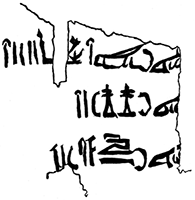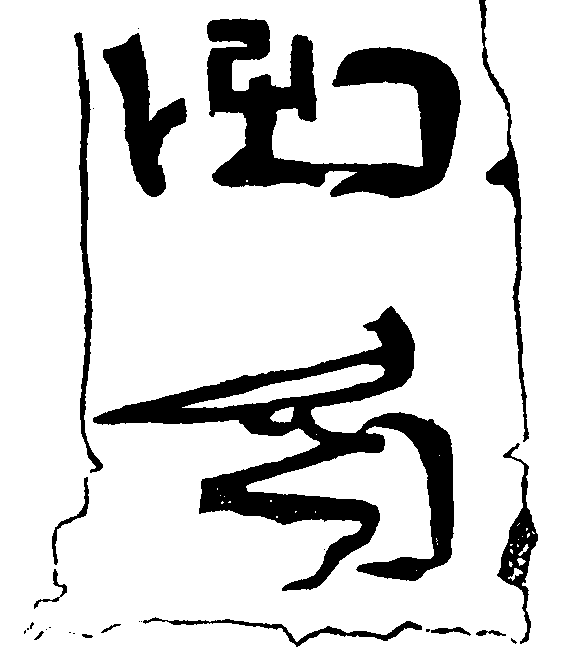Note on a fragment of the Royal Papyrus and the Sixth Dynasty of Manetho
Auguste Mariette
1849
Note on a fragment of the Royal Papyrus of Turin and the Sixth Dynasty of Manetho.
I do not know why nobody used the hieratic papyrus discussed here, for the reconstruction of the first Egyptian dynasties, before Mr. Bunsen.1 In 1841, Mr. Birch of the British Museum said that, far from introducing into historical criticism a series of new facts, the papyrus would at best be sufficient to confirm that which already has been proven elsewhere.2 Mr. Barucchi3 held this famous document in the same disdain, and this is all the more understandable from the respectable director of the Turin Museum, as he was in a better position than anyone to consult it, as well as to verify and control the arrangement proposed by Mr. Lepsius.4
Mr. Bunsen and Mr. de Rougé (the latter in his beautiful refutation5 of the work of the German scholar) first used the papyrus to review the early stages of the Egyptian monarchy. Although still reluctant to use a weapon so deteriorated by time, they have used it with some advantage and shown that after all, we must not put it completely out of the way, as Mr. Barucchi wrote. Overall, the papyrus thus still has its value, and the sum of the facts, thanks to Mr. from Rougé and Bunsen, it has introduced to science, deserves to be taken into consideration.
Certainly, I know well that those who, in spite of Champollion’s two warnings,6 have forgotten that the papyrus existed did not act without some reason. This precious monument is indeed in a deplorable state of deterioration. Nevertheless, these fragments would still help if placed in their correct position. The problem is therefore to find their place, and it is precisely because of the deterioration of the papyrus that it is our duty not to neglect any observation, however small, which would have the result of properly determining the position of one or more of its fragments. It is one of these observations, short and elementary, that I submit for the reader to acknowledge. I hope it will come out clearly:
- One of the fragments, No. 41 of Mr. Lepsius,7 is not in the correct position;
- That the whole of the Fifth and Sixth Dynasties of Manetho is clearly recognized on the papyrus, and as distinct is the whole of the Twelfth Dynasty which has enriched the history of Egyptian archaeology since the death of Champollion;
- Finally, more considerable, Manetho and the papyrus verify each other, and that due to this, Manetho loses nothing of his authority.
We know that Mr. Bunsen has established the record of the great fragment No. 32 of the papyrus8 and the Fifth Dynasty of Manetho. This fragment ends with three cartouches that it is useful to reproduce.
Here they are in hieratic and in hieroglyphs:

They read: 1. Menkeher 2. Tet 3. Unas.
Now it is very difficult for these three ings not to be Μενχερης, Τανχερης, Οϐνος, of Africanus,9 especially if, following a variant of the only good manuscript we have of Syncellus, we substitute Οννος for Οϐνος.
The identification therefore seems certain, although a little too bold for Mr. Bunsen, who bases his work on the mere resemblance of names and figures. By admitting that the name of Nicotris has not yet been found on monuments, deprives himself of the assistance that the presence of the name of this seventh queen after Unas would have lent him, where precisely the discovery of the last three sovereigns of the Fifth Dynasty the papyrus forced us to read as Nitocris.
It is Mr. de Rouge who, in his turn, broke the barrier of Mr. Bunsen,10 and corroborated the assimilation of Onnos to Unas by reading the cartouche of Nitocris just indicated.
Constructed with a certain regularity, the resemblance between Manetho and the papyrus became more and more satisfactory. Apart from any other proof, our two authorities agree.
I do not believe that the slightest doubt has arisen among Egyptologists on this question. Mr. Lesueur alone protested,11 without our knowing why, for he probably did not give us all his reasons, he placed the fourth column12 in the Sixteenth Dynasty, where the old Unas is astonished to find himself following Ramesses V.
Whatever merit should be accorded to the work of Mr. Lesueur, I think that in this he has been seriously mistaken. If there were doubts, they should not result in such a strange upset. In addition, there are indeed some doubts. Fragments 32 and 43, reading the names Unas and Nitocris, do not stand, and Manetho himself, whose data is verified by the text of the papyrus, was able to provide Mr. Lepsius with order in which he arranged these two fragments. Moreover, in the arrangement just indicated, the Sixth Dynasty of Africanus is no longer recognizable, and it is not without concern that instead of the well known Phiops and Menthesouphis, we see names that are not at all those of these monarchs. In short, the objections were not absolutely wanting, since the Sixth Dynasty of the papyrus was in opposition to that of Manetho. The cartouche of Nitocris could therefore no longer be in its place, the question returned to the point where Mr. Bunsen had left it, and there is real doubt about the reciprocal position of all the fragments of the group of the four cartouches.
Fortunately, we find unexpected help in the figures of the papyrus compared to those of Manetho, and the Sixth Dynasty is now easy to revive almost entirely. These figures bind all the fragments together, and our two authorities will agree about perfect string of nine kings. The comparison of the papyrus and Africanus give:
| FIFTH DYNASTY | |||
| A F R I C A N U S | P A P Y R U S | ||
| Mencheres | 9 years | Menkaher | 8 years, ? months |
| Tancheres | 44 years | Tet | 38 years |
| Onnos | 33 years | Unas | 30 + ? years |
| SIXTH DYNASTY | |||
| A F R I C A N U S | P A P Y R U S | ||
| ... | ... | Missing | 6 months, 21 days* |
| Othoes | Missing | Missing | Missing |
| Phios | 53 years | Missing | 20 years |
| Menthesuphis | 7 years | Missing | 4 days |
| Phios | 94 years | Missing | 90 + ? years |
| Menthesuphis | 1 years | Missing | 1 year, 1 month |
| Nitocris | 12 years | Nitocris | Missing |
* There are seven kings in the papyrus while Manetho only give six.
Now if Menkeher, Tet and Ounas are not Mencheres, Tancheres and Onnos of Africanus, it is at least diffucult. If there is not complete certainty, there are probabilities such that if we challenged them, we would now have to wipe out from the annals of history a host of facts that are not based on solid evidence that are none the less acquired from science. Therefore, a whole column and the head of two others are perfectly determined. The reading of the name Nitocris by Mr. de Rougé, who confirmed the discovery of the three kings of Mr. Bunsen, is in turn verified by the figures of the papyrus. In short, we can see that, this part of the famous document of Turin is reconstructed with precision.
A few short comments run the entire discussion.
Mr. Lesueur, as I have already said, place Unas, on page 246 of his Memoir, among the kings of the Sixteenth Dynasty. I do not know why the satisfactory ensemble, which we arrived at a moment ago, did not please Mr. Lesueur. The fact is even more astonishing that this scholar had read not only the three cartouches, which we have reproduced,13 but also the figures of the following dynasty,14 and even more remarkably, the cartouche of the vultu rubicunda of Goar.15
Now why is not the name Nitocris of Mr. Lesueur that of the Nitocris of Manetho; Why is not Unas of the monuments Onnos of the Fifth Dynasty? It is first because Mr. Lesueur forgot that Unas unquestionably figure on monuments prior to the Twelfth Dynasty, and then because Queen Nitocris last of who ended the Sixth Dynasty, which Mr. Lesueur makes Nitocris[16] as the first king of the Eighth.
However, it is precisely with the cartouche of queen Nitocris that Mr. Lesueur arranges an unknown Nitocris to history. He announces that the papyrus gave him the name spelled Netaktri, devoid of a feminine mark.[17]
On this fact alone, Mr. Lesueur claims that Nitocris is no longer a queen, but a king. As this question touches closely on various delicate points of Egyptian archeology, it is necessary to seek a solution. Before trying it, please note two facts.
The first that Mr. Lesueur has read Netaktri, we actually read , Netaker, according to the transcript of Mr. de Rougé.[18]
Here the feminine form is clear; and the  of the hieratic is not better suited to a king than a queen; it is an acronym of honor which, in the hieratic writing, accompanies every cartouche and can be transcribed indifferently by the determinative of a man
of the hieratic is not better suited to a king than a queen; it is an acronym of honor which, in the hieratic writing, accompanies every cartouche and can be transcribed indifferently by the determinative of a man or a woman
. It corresponds in the papyrus to the title
 which invariably accompanies the royal names.[19] Also,
which invariably accompanies the royal names.[19] Also, Aktri is a barbarism of which nothing authorizes the introduction in the Egyptian language.
The inscriptions of all eras give constantly , Aker, victory, that in coptic is well preserved in the form ϫⲣⲟ, said., or ϭⲣⲟ, memph. Mr. Lesueur tries in vain to prove that
, Aktri, is the ancient form of
, Aker, and supports this hypothesis after which the name Sesostris would have been written
, Sesaktri, the victorious son. This has no real foundation, this reading is due to the imagination of Mr. Lesueur, and the reading of a masculine name, Netaktri, is false.
The second fact is that Eratosthenes translated Nitocris by
This rule is evident from the classification of the four or five hundred known Egyptian proper names, among which we find those of , Horus,
, Unnofre,
, Pnebmonth (the Lord Month),
, Sebeknakht (Sebek the powerful), for men; and for women those of
, Hathor,
, Isis,
, Hakte, but among which one will never find a name of god borne by a woman, or a name of goddess by a man.[23] King Nitocris of Mr. Lesueur is thus once again wrong here, and the annals of Egypt will not furnish us with more Pharaohs of this name, than the history of Rome will give us of an emperor by the name of Agrippina, or the history of France naming a king Catherine de Medici.
Now the question itself, and the observations it raises.
These observations tend to prove that, in the cartouches of queens, the mark of the feminine could often be omitted, when the cartouche was that of a woman invested with supreme power. Mr. Lesueur himself furnish us with proof. This, I believe, is what puts this point beyond doubt, and at the same time what completes, according to the monuments, the whole of the Twelfth Dynasty, as given to us by Manetho.[24]
Mr. de Rouge very cleverly established,[25] according to Mr. Lepsius, that the last cartouche of the Twelfth Dynasty in the Papyrus,[26] of which here is the transcription: is the one to belong to the last named of the same dynasty of Manetho. In the third line of the Thutmes III room, it reads:
In addition, as can be noticed, that here, no more than on the papyrus, it is not accompanied by the feminine form. Now this last name is queen Skemiophris,[27] evident corruption of Rasebeknofru which one reads in the preceding cartouches.
I know very well that, the doubt in which the absence of the feminine was implied, Mr. de Rougé made Sebeknofre a king, the husband of a princess who would have called him to the throne. However, since then, this scientist has modified his opinion, and I think like him that the absence of the mark of the feminine proves nothing and that Sebeknofre[28] is a queen who would have occupied the last place in the list of monarchs of the Twelfth Dynasty.
The proof of this last assertion is easy to establish.
A constant fact is that private individuals have often attributed to themselves, not only the proper name of a king, with or without a cartouche, such as , Amenemhe,
, Sesustasen, and many others, but also his royal name,[29] such as
, Raterka,
, Raschakasenb, of stele No. 23 in the Louvre. Women have even called themselves
, Setraterka.
This custom, doubtless born from the veneration and gratitude of the people, included not only the kings; queens also merited this honor. The name Sebeknoferu was so often worn by women after the Twelfth Dynasty, that it is impossible that, like the men who called themselves Raterke, etc., these women did not wear their name in memory of an illustrious queen, the direct ancestor of the monarchs under whom they lived. A very curious stele of the Louvre[30] with the name , Sebeknoferu, of a woman who had lived at the court of a queen of the Fifteenth Dynasty, named Noubshaes. On another stela,[31] the sister of an important official named Nantef, has the same name. Sebeknofre is very obviously a woman’s name. It may therefore be that the primitive form of Skemiophris, and Mr. Lesueur, who transcribed[32] this cartouche of a queen without the feminine form, which has proved to us that we could do without this grammatical precaution when the name was that of a woman acting as king.
Everything is therefore united to repel the conjectures by which Mr. Lesueur present Nitocris as a king, and to confirm the arrangement we have proposed for the fragments of the papyrus, where the names Onnos, Nitocris, and the figures of the Sixth Dynasty are inscribed.
There remains to say something about the identification of Nitocris as the Queen of Manetho in the papyrus, there appear two names after Nitocris in the papyrus Neferka and Snefru, which must be identical to
, Snefru and Neferkara (
From the preceding, it follows that the whole group of fragments of the papyrus encompassing a column, and the head of the two following ones are recognizable in a satisfactory way. I said earlier that at the head of the fifth column, it was astonishing to find names that are not those of Phiops and Menthesuphis of Manetho; it is because these names, transcribed by the papyrus in this form:

read as Menes and Athothis:
As we see, I had some reason to announce that Mr. Lepsius’s fragment No. 41 is not in the place it must occupy. I hope that these simple clarifications will leave no doubt in the mind of the reader on the Sixth Dynasty part of the papyrus. The authority that this fragment of history, written in the eighteenth century before our era, lend to the lists of Manetho, lists so distorted from Eusebius to us by the enemies of Egyptian antiquity, and yet monuments confirm the authenticity and accuracy. The Sebennyte priest is once again victorious in this trial.
There is no longer any doubt that he did not draw from the good sources, and that there existed in the political archives of Egypt a chronicle of time, a
Auguste Mariette
Employee of the department of antiquities and sculptures of the Louvre.
2 Gallery of antiquities, p. 68.
3 Discorsi critici sopra la cronologia egizia.
4 Auswahl, taf. III, IV, V, VI. Champollion had worked on the papyrus. This fact was revealed to us by Mr. Champolion-Figeac in l’Univers pittoresque, 1839 (Eg., 277), and then in the Nouvelle Revue encyclop. (June 1846, pp. 222 et seq.) The details supplied by Mr. Champollion-Figeac give the impression that this work must have been, if not complete, at least extensive. It would be desirable to be found again. I will point out that Mr. Champollion-Figeac has given us two different translations of the same passage, which relates to the years of King Menes (Univ Pitt, pp. 277, B, line 26, and Revue encycl., p. 229, line 9), and he announces that these two versions are from his brother’s manuscripts. Champollion could not, in the same work, vary so much. This remark makes us think that Champollion has, no doubt, twice exercised his piercing criticism of the papyrus, and this circumstance would explain quite well the involuntary contradictions by his brother.
5 Annales de Philosophie chrétienne, t. XIV, XV, XVI (3e série).
6 Lettres au duc de Blacas d’Aulps, 2e lettre, p. 43, and Bulletin universel, nov. 6, 1824.
7 i>Auswahl, pl. IV, top of 5th col.
8 Auswahl, pl. IV.
9 Apud Syncell., p. 107. Dindorf.
10 Annales de Phil. chrét.
11 Chronologie des rois d’Égypte. Imp. nat.
12 Ibid., p. 246.
13 Chron., p. 324.
14 Ibid., p. 266
15 Ibid., p. 268
16 Ibid., p. 223 and 268
17 Ibid.,
18 Annales de Phil. chrét.
19 This well-known title is often used in hieroglyphs, in this form
20 Apud Syncell., p. 195. Dindorf.
21 In Tim.
22 Adv. gentes, IV, 16, pl. V, p. 1034. Migne.
23 It is understood that it is necessary to except from this rule the proper names which, by their very essence, belong to both sexes. Such are Phtahmai, Amunmai, Thutmes, Aahmes, etc., which also mean the beloved or beloved of Ptah, Ammon, the begotten or begotten of Thoth, of Lunus. These four names are worn by men and women mentioned on steles of the Louvre.
24 Syncell., p. 3, Dindorf
25 Annales de Phil. chrét.
26 Auswahl, pl. V., col. 7.
27 Syncell., p. 111, Dindorf
28 Here one would think that a woman wears the name of the god Sebek and that it would be an exception to the rule posed earlier. Observe that the character
29 These facts do not occur for the royal names, until the Twelfth Dynasty and the Saite period. In the time of the Psammitichus, we have the official of the house of Khufu (Cheops)
30 No. 45.
31 No. 47.
32Chronol., pl. V.
33 p. 95, Dindorf.
34 The whole Greek tradition is proof of this usage. See especially Cicero, De Republ., III, 6, Plato in Tim. and Josephus, Contra App., I, 11.